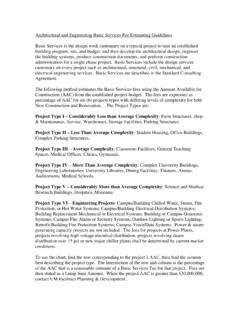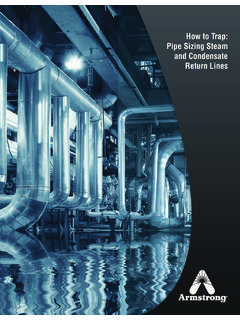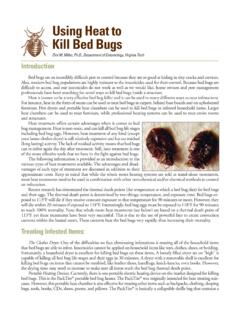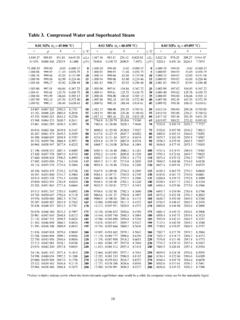Transcription of GENERAL: DESIGN GUIDELINES: A. Design General
1 CONSULTANT PROCEDURES & DESIGN GUIDELINES UNIVERSITY OF MISSOURI 232200 steam and Condensate Piping and Pump Systems Revised 12/20/2013 Page 1 of 7 232100 General : steam and condensate piping and pump systems included in this document are for building systems starting at the pressure reducing station (PRV). DESIGN GUIDELINES: A. DESIGN General 1. Definitions: Low pressure steam is 15 psig or less. High pressure steam is above 15 psig. 2. Campus Systems: MU: The steam distribution system operates at 60 psig and 400 F degrees. All equipment using campus steam must be capable of using steam at a temperature of 350F degrees.
2 Confirm this with the Project Manager. Kansas City: Cooling Season: The steam distribution system operates as a single system at a common pressure of 10 to 15 psig. The system is supplied from one 300 hp boiler in Spencer Chemistry. Heating Season: The steam distribution system is decoupled at SMH 2. The distribution system east of SMH 2 is operated at 15 psig from one 600 hp boiler in Spencer Chemistry. The line to Flarsheim is supplied from Miller Nichols at 15 psig when ambient temperature is above 40 F and at 50 psig when ambient temperature is below 40 F. The lines west of Miller Nichols are supplied from Miller Nichols at 10 to 15 psig.
3 3. ALL steam used in heating systems will be used at a reduced pressure of 15 psig or less. Designer shall calculate the pressure required as indicated below. A working pressure of 5 to 8 psig is preferred. 4. High pressure steam may be used in a process heating application (autoclaves, cagewashers). B. Pipe S izing 1. Pipe sizing for low pressure steam and condensate returns shall be based on table found in the ASHRAE handbook, Fundamentals. Consultant shall size pipe and Pressure reducing valves will not be set higher than the minimum needed to deliver the necessary flow and pressure at the furthest point of use.
4 2. Pipe steam velocity should not exceed 8000 to 12000 fpm. CONSULTANT PROCEDURES & DESIGN GUIDELINES UNIVERSITY OF MISSOURI 232200 steam and Condensate Piping and Pump Systems Revised 12/20/2013 Page 2 of 7 232100 3. One pipe steam /condensate piping systems shall not be used. Older systems scheduled for renovation shall be changed to 2 pipe steam /condensate systems. 4. Condensate return piping shall be sized per ASHRAE handbook, Fundamentals for dry return. C. Piping system DESIGN 1. steam piping shall slope in the direction of steam flow at in 10 ft. Condensate shall slope in 10 ft.
5 2. All steam risers shall be provided with drip legs per detail x. 3. All branch lines shall connect to main piping within 45 degrees to the top of the pipe. See detail x. 4. Exception: steam main lines may be bottom tapped if the branch is provided with a trap at the tap. See detail x 5. Branch lines less than 10 ft long shall slope back to the main. Branch lines exceeding 10 ft will slope in the direction of flow and be trapped before entering any control device. 6. All sections of steam and condensate lines, which can be isolated with shutoff valves, shall be provided with a vent valve, drain valve and pressure gauge connection.
6 7. Do NOT use a vacuum condensate return. 8. Piping systems shall be analyzed for thermal expansion. Systems in buildings should be designed with anchor points, which take advantage of the typical pipe routing to achieve a flexible DESIGN . DO not use expansion joints, or flexible pipe couplings inside buildings. Solid pipe expansion loops are required. 9. All condensate piping shall be designed to drain by GRAVITY to the condensate return pump. steam condensate after a heat exchanger or coil will not run up hill. Condensate risers which fill with condensate will cause dangerous steam hammer.
7 Where condensate cannot be drained by gravity, and small condensate pump shall be provided. Equipment, such as heat exchangers may need to be elevated to provide proper drainage. Condensate Pumps may be required to be in pits or trenches. CONSULTANT PROCEDURES & DESIGN GUIDELINES UNIVERSITY OF MISSOURI 232200 steam and Condensate Piping and Pump Systems Revised 12/20/2013 Page 3 of 7 232100 D. Pressure Reducing V alves 1. All pressure reducing valve stations serving an entire building will have 2 pressure reducing valves, sized at 1/3 and 2/3 of the total load. Bypass lines are not required.
8 Follow the Spence Regulator, Designers guide for sizing and layout of PRV stations. 2. Pressure reducing valves shall be selected and specified around a Spence, Type E valve, with pilot positioners. See figure x for approved installation drawings. 3. A vertical PRV station, mounted against the wall, is preferred. Ceiling mount is acceptable only if wall location is not available. Ceiling mounted units should not exceed 8 ft above finished floor. 4. Pressure reducing valves shall not exceed 85db when measured 3 feet from the valve. 5. Pressure Reducing Valves shall be located in Mechanical Rooms.
9 Do not locate PRVs in hallways or other rooms not suitable for this service. E. steam Traps 1. Provide steam traps per detail _____ 2. Primary building heat exchangers will be provided 2 float and thermostatic steam traps on each heat exchanger. 3. All steam pre-heat coils will be provided with 2 F&T traps on each coil. 4. All Drip stations on steam mains shall have a inverted bucket trap. 5. Where steam condensate cannot be drained by gravity, pumping steam traps shall be provided. Sarco PPT is preferred and drawing details shall be per Sarco instructions. F.
10 Main Condensate Return Pumps 1. All condensate for a building shall routed to a duplex condensate return pumps. Unless the facility is a major complex of buildings, one duplex pump is preferred. 2. MU Only: Pressure powered pumps, using 60 psi steam as the motive force are required, unless location of the facility requires higher pumping head. 3. When pumps heads higher than 45 psi are expected, DESIGN shall be based on a Grunfos _____ duplex pump. CONSULTANT PROCEDURES & DESIGN GUIDELINES UNIVERSITY OF MISSOURI 232200 steam and Condensate Piping and Pump Systems Revised 12/20/2013 Page 4 of 7 232100 SPECIFICATIONS: A.







